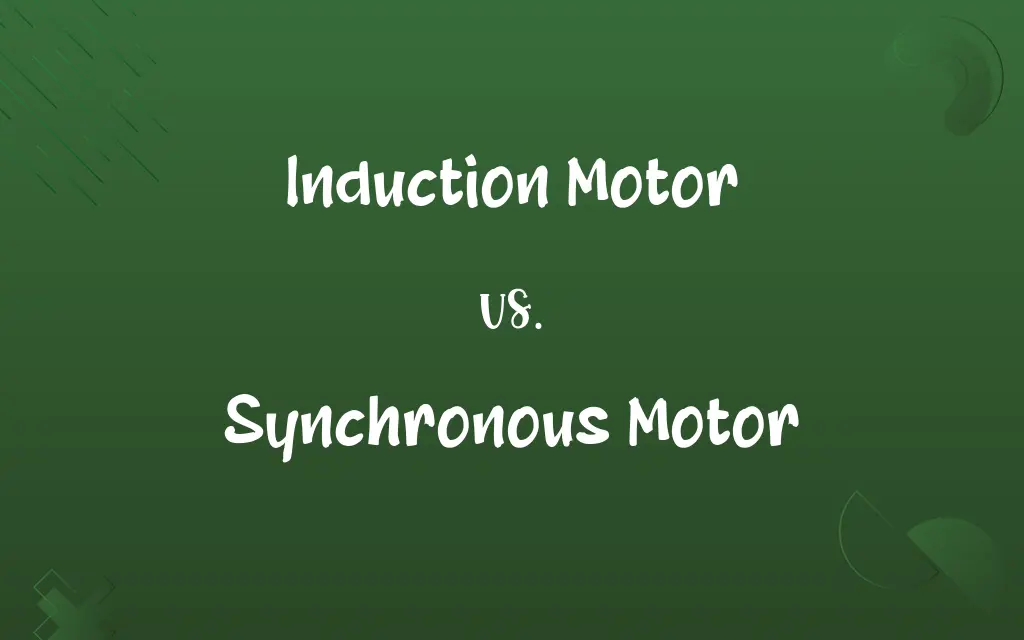Induction Motor vs. Synchronous Motor: Know the Difference

By Shumaila Saeed || Updated on December 25, 2023
An induction motor runs slightly slower than the power supply frequency, using electromagnetic induction, while a synchronous motor runs at exact supply frequency speed, using direct current.

Key Differences
Induction motors operate on the principle of electromagnetic induction, where the rotating magnetic field induces a current in the rotor. Synchronous motors, however, operate by receiving direct current that synchronizes the rotor speed with the frequency of the supply current.
Shumaila Saeed
Dec 10, 2023
Induction motors run slightly slower than the supply frequency (asynchronous speed), as their speed varies with load. In contrast, synchronous motors maintain a constant speed, equal to the supply frequency, regardless of load conditions.
Shumaila Saeed
Dec 10, 2023
Induction motors are generally simpler and more rugged in construction compared to synchronous motors, which require additional components like slip rings and brushes for direct current supply.
Shumaila Saeed
Dec 10, 2023
Induction motors are widely used in applications where speed variation and less complex control are acceptable, such as fans, pumps, and general industrial machinery. Synchronous motors are preferred in applications requiring precise and constant speed, such as in power generation or synchronous clocks.
Shumaila Saeed
Dec 10, 2023
Induction motors are typically more cost-effective and energy-efficient for variable-load applications. Synchronous motors, though more expensive and complex, offer higher efficiency in constant-speed applications and can operate at leading power factors.
Shumaila Saeed
Dec 10, 2023
ADVERTISEMENT
Comparison Chart
Operating Principle
Uses electromagnetic induction to rotate the rotor.
Operates by synchronizing rotor speed with supply frequency.
Shumaila Saeed
Dec 10, 2023
Speed Regulation
Speed varies with load; runs slower than supply frequency.
Maintains a constant speed equal to the supply frequency.
Shumaila Saeed
Dec 10, 2023
Construction
Simpler, more rugged design.
More complex, often includes slip rings and brushes.
Shumaila Saeed
Dec 10, 2023
Applications
Suited for general industrial use with variable speeds.
Used in precise, constant-speed applications.
Shumaila Saeed
Dec 10, 2023
Cost and Efficiency
Cost-effective for variable loads; good energy efficiency.
Higher efficiency in constant-speed; more expensive.
Shumaila Saeed
Dec 10, 2023
ADVERTISEMENT
Induction Motor and Synchronous Motor Definitions
Induction Motor
They are commonly used in applications where variable speed and less maintenance are important.
Most household washing machines use an induction motor for their various cycle settings.
Shumaila Saeed
Dec 03, 2023
Synchronous Motor
A synchronous motor is an AC motor that operates at a speed synchronized with the supply frequency.
The synchronous motor in the clock ensures it keeps accurate time with the mains frequency.
Shumaila Saeed
Dec 03, 2023
Induction Motor
Induction motors are characterized by their rugged construction and simplicity.
The robust induction motor is ideal for the harsh conditions in the manufacturing plant.
Shumaila Saeed
Dec 03, 2023
Synchronous Motor
It maintains constant speed irrespective of load variations.
The printing press uses a synchronous motor for consistent speed during operation.
Shumaila Saeed
Dec 03, 2023
Induction Motor
It is a type of asynchronous motor where the rotor speed is less than the magnetic field speed.
The fan's induction motor allows for varying speeds under different load conditions.
Shumaila Saeed
Dec 03, 2023
ADVERTISEMENT
Synchronous Motor
They are ideal for applications requiring precise and uniform speed.
Synchronous motors are used in power plants for consistent and efficient power generation.
Shumaila Saeed
Dec 03, 2023
Induction Motor
An induction motor is an electric motor that operates on electromagnetic induction.
The induction motor in the conveyor belt provides reliable and efficient operation.
Shumaila Saeed
Dec 03, 2023
Synchronous Motor
Synchronous motors can improve power factor in electrical distribution systems.
The plant installed a synchronous motor to improve its overall power factor and reduce energy costs.
Shumaila Saeed
Dec 03, 2023
Induction Motor
Induction motors are efficient for a wide range of industrial and domestic applications.
The induction motor in the water pump ensures energy-efficient operation.
Shumaila Saeed
Dec 03, 2023
Synchronous Motor
Synchronous motors require direct current for excitation of the rotor.
The large synchronous motor in the factory has separate excitation for precise speed control.
Shumaila Saeed
Dec 03, 2023
Repeatedly Asked Queries
How does an induction motor work?
It works by inducing an electric current in the rotor through a rotating magnetic field.
Shumaila Saeed
Dec 10, 2023
What is an induction motor?
An electric motor that operates on electromagnetic induction.
Shumaila Saeed
Dec 10, 2023
How does a synchronous motor work?
It operates by synchronizing the rotor speed with the frequency of the supply current.
Shumaila Saeed
Dec 10, 2023
Do induction motors require a lot of maintenance?
No, they are generally low-maintenance due to their rugged construction.
Shumaila Saeed
Dec 10, 2023
Are induction motors efficient?
Yes, they are efficient, especially for variable-load applications.
Shumaila Saeed
Dec 10, 2023
What is a synchronous motor?
An AC motor that operates at a constant speed synchronized with the supply frequency.
Shumaila Saeed
Dec 10, 2023
Are synchronous motors efficient?
Yes, especially in constant-speed applications.
Shumaila Saeed
Dec 10, 2023
What are typical uses of synchronous motors?
Used in power generation, precise speed applications, and improving power factors.
Shumaila Saeed
Dec 10, 2023
Do synchronous motors require a lot of maintenance?
They can require more maintenance due to their complexity and components like slip rings.
Shumaila Saeed
Dec 10, 2023
Can synchronous motors vary their speed?
They are designed to run at a constant speed, synchronized with the supply frequency.
Shumaila Saeed
Dec 10, 2023
Are induction motors used in power plants?
They are not typically used in power generation but in auxiliary applications.
Shumaila Saeed
Dec 10, 2023
Do induction motors require an external DC source?
No, they do not require an external DC source for operation.
Shumaila Saeed
Dec 10, 2023
What are typical uses of induction motors?
They are used in household appliances, industrial machinery, and HVAC systems.
Shumaila Saeed
Dec 10, 2023
Can induction motors run at a constant speed?
No, their speed varies with load.
Shumaila Saeed
Dec 10, 2023
How is the speed of a synchronous motor controlled?
By controlling the frequency of the supply current.
Shumaila Saeed
Dec 10, 2023
Do synchronous motors require an external DC source?
Yes, they require a DC source for rotor excitation.
Shumaila Saeed
Dec 10, 2023
Are synchronous motors used in domestic applications?
Rarely, as they are more suited for industrial and precision applications.
Shumaila Saeed
Dec 10, 2023
What is the power factor of induction motors?
They typically operate at a lagging power factor.
Shumaila Saeed
Dec 10, 2023
What is the power factor of synchronous motors?
They can operate at unity or leading power factors.
Shumaila Saeed
Dec 10, 2023
How is the speed of an induction motor controlled?
Through varying voltage and frequency or using VFDs (Variable Frequency Drives).
Shumaila Saeed
Dec 10, 2023
Share this page
Link for your blog / website
HTML
Link to share via messenger
About Author
Written by
Shumaila SaeedShumaila Saeed, an expert content creator with 6 years of experience, specializes in distilling complex topics into easily digestible comparisons, shining a light on the nuances that both inform and educate readers with clarity and accuracy.








































































